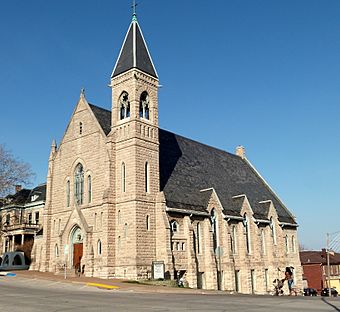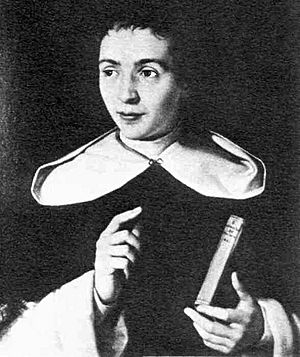St. Paul's Catholic Church (Burlington, Iowa) facts for kids
Quick facts for kids |
|
|
St. Paul's Roman Catholic Church
and Rectory |
|
|
U.S. Historic district
Contributing property |
|

St. Paul's Church in 2013
|
|
| Location | 508 N. 4th St. Burlington, Iowa |
|---|---|
| Area | 2.35 acres (0.95 ha) |
| Built | 1892-1895 (church) 1902-1904 (rectory) |
| Architect | James J. Egan |
| Architectural style | Gothic Revival (church) Georgian Revival (rectory) |
| Part of | Heritage Hill Historic District (ID82000406) |
| Added to NRHP | December 21, 1982 |
St. Paul's Catholic Church is an old and important church building in Burlington, Iowa, United States. It is part of the Divine Mercy parish, along with the Church of St. John the Baptist in Burlington and St. Mary's Church in West Burlington. These churches are all part of the Diocese of Davenport. The buildings of St. Paul's Church and its rectory (the priest's house) are special because they are listed in the Heritage Hill Historic District on the National Register of Historic Places. This means they are important historical places.
Contents
History of St. Paul's Church
In 1836, Burlington was chosen as a temporary capital for the Wisconsin Territory. Then, in 1838, it became the first capital of the Iowa Territory. Because of its importance, church leaders like Bishop Mathias Loras and Reverend Samuel Charles Mazzuchelli saw that Burlington needed a Catholic church.
In 1839, Reverend Mazzuchelli bought land in Burlington to start St. Paul's Church. A small brick church was built between 1840 and 1841. It was located where the back of the current church stands today. The first church bell in Burlington arrived in 1842. This early church building was even used by the territorial government for 60 days.
To help Catholicism grow, Bishop Loras chose St. Paul's for an important event: the ordination of Reverend Anthony Godfert, a priest Loras had brought from France. Later, when there were disagreements between Irish and German Catholics in Dubuque, Bishop Loras came to Burlington. He sent St. Paul's pastor, Reverend John Healy, to try and fix the problems.
After Bishop Loras left, other priests visited Burlington regularly. Reverend J.A.M. Pelamourgues from St. Anthony's in Davenport often helped. In 1847, Reverend John George Alleman arrived. He stayed for a few years until Reverend George Reffe came. In 1849, Reverend Reffe started Burlington's first parochial school (a church-run school) in the church basement. The Sisters of Charity of the Blessed Virgin Mary began teaching at St. Paul's in 1859. A second, larger brick church, built in the English Gothic style, was finished in 1863.
Building the Current Church
The St. Paul's Church you see today was designed by Chicago architect James J. Egan. He designed it in the High Victorian Gothic Revival style. He also designed other important churches like Sacred Heart Cathedral in Davenport and St. Ambrose Cathedral in Des Moines. All three churches share some similar features.
The first stone for the current church was laid on October 23, 1892, when Reverend Bernard Mackin was the pastor. John Loftus built the church, and it was finished in 1895. The church was officially opened on January 27, 1895. In 1946, a fire damaged the church, and its inside had to be completely rebuilt.
Changes in Schools and Parishes
Over time, the Catholic schools in Burlington started to combine. St. Paul's and St. John's both had high schools, but they merged in 1958 to create Notre Dame High School. The grade schools of St. Paul's and St. John's also combined in 1975. St. Paul's School taught kindergarten through 4th grade, while St. John's taught grades five through eight. Other Catholic schools in Burlington and West Burlington had closed earlier. In the 1990s, money was raised to add a new grade school section at Notre Dame.
The number of priests in the Davenport Diocese has decreased since the 1960s. Also, the number of people attending church in Burlington changed. In 1991, Bishop Gerald Francis O'Keefe announced a plan to combine parishes across the diocese, and Burlington's churches were part of this plan. In 1998, St. Paul's and St. John's churches joined together. Their new parish was called Saints John and Paul. At the same time, St. Patrick's and St. Mary's churches also merged to form their own parish. Then, in 2017, Saints John and Paul parish and St. Mary and St. Patrick parishes merged again to form the current Divine Mercy parish.
Architecture of the Church and Rectory
St. Paul's Church Building
St. Paul's Church is built from Bedford limestone. On the right side of the front of the church, there is a tall tower that reaches 100 feet (30 meters) high. The original church bell from 1842 is still in this tower. The church is on a corner lot at the top of a hill, which makes it stand out. This also means the church's basement is visible at the back.
The sides of the church have sections separated by strong buttresses (supports). Three gables (pointed roof sections) break up the roofline on the sides. You can see decorative stone patterns called Tracery and tall, narrow lancet windows alternating along the sides. Above the main entrance, there is a tall tracery window with two shorter lancet windows on either side.
Inside, the church is a large open space with no pillars. The pews (church benches) are arranged in four sections. The vaulted ceiling (a curved ceiling like an arch) is held up by strong hardwood hammer beams. The altar (the table where services are held) is framed by a tall, pointed arch. On either side of the altar are special areas with shrines. On the left is the tabernacle (where the Eucharist is kept) with a statue of the Sacred Heart of Jesus above it. On the right is a shrine with statues of the Blessed Virgin Mary and Saint Joseph. Above the altar are three stained glass windows, with the central one showing Saint Paul the Apostle. A pipe organ is located in the back of the church, in a raised area called the gallery.
St. Paul's Rectory Building
St. Paul's Rectory, the house next to the church, was designed by Egan & Prindeville. It was built between 1902 and 1904 in the Georgian Revival style. It's a two-story house with a steep, multi-level hipped roof covered in slate. Small dormers (windows that stick out from the roof) are on all sides, and decorative blocks called modillions are under the eaves (the part of the roof that hangs over the walls). Tall stone chimneys rise above the roof.
The outside of the house is covered with smooth, cut stone blocks called ashlar, mixed with narrower, rougher stone blocks. The house is mostly rectangular, but the front part on the north side sticks out a little. The front porch has a railing and is supported by three simple columns. Another porch on the southeast corner of the house has been screened in. A newer addition was built at the back of the house, extending the length of the back porch.




